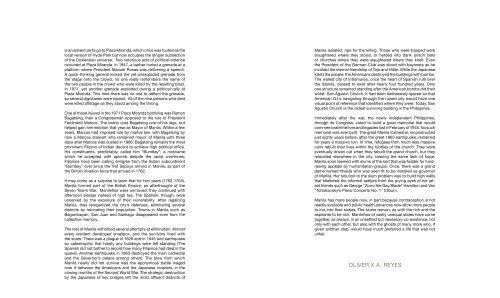You also want an ePaper? Increase the reach of your titles
YUMPU automatically turns print PDFs into web optimized ePapers that Google loves.
is an adventure to go to Plaza Miranda, which once was touted as the<br />
local version of Hyde Park but now occupies the dingier subsection<br />
of the Dickensian universe. Two notorious acts of political violence<br />
occurred at Plaza Miranda. In 1947, a barber hurled a grenade at a<br />
platform where President Manuel Roxas was delivering a speech.<br />
A quick-thinking general kicked the yet-unexploded grenade from<br />
the stage onto the crowd; no one really remembers the name of<br />
the two people in the crowd who were killed by the resulting blast.<br />
In 1971, yet another grenade exploded during a political rally at<br />
Plaza Miranda. This time there was no one to deflect the grenade,<br />
so several dignitaries were injured. All of the nine persons who died<br />
were killed offstage as they stood among the throng.<br />
One of those injured in the 1971 Plaza Miranda bombing was Ramon<br />
Bagatsing, then a Congressman opposed to the rule of President<br />
Ferdinand Marcos. The bomb cost Bagatsing one of his legs, but<br />
helped gain him election that year as Mayor of <strong>Manila</strong>. Within a few<br />
years, Marcos had imposed rule by martial law, with Bagatsing by<br />
now a Marcos stalwart who remained mayor of <strong>Manila</strong> until three<br />
days after Marcos was ousted in 1986. Bagatsing remains the most<br />
prominent Filipino of Indian decent to achieve high political office.<br />
His constituents, predictably, called him “Bumbay”; a nickname<br />
which he accepted with aplomb despite the racist overtones;<br />
Filipinos have been calling émigrés from the Indian subcontinent<br />
“Bumbay” ever since the first Sepoys arrived in <strong>Manila</strong>, as part of<br />
the British invasion force that arrived in 1762.<br />
It may come as a surprise to learn that for two years (1762-1764),<br />
<strong>Manila</strong> formed part of the British Empire, an afterthought of the<br />
Seven Year’s War. Manileños were unmoved; they continued with<br />
afternoon siestas instead of high tea. The Spanish, though, were<br />
unnerved by the exposure of their vulnerability. After regaining<br />
<strong>Manila</strong>, they reorganized the city’s defenses, eliminating several<br />
districts by relocating their population. Towns in <strong>Manila</strong> such as<br />
Bagumbayan, San Juan and Santiago disappeared even from the<br />
collective memory.<br />
The rest of <strong>Manila</strong> withstood several attempts at elimination. Almost<br />
every resident developed smallpox, and the survivors lived with<br />
the scars. There was a plague in 1628 and in 1645 and earthquake<br />
so catastrophic that hardly any buildings were left standing (The<br />
Spanish did not bother to record how many Filipinos had died in the<br />
quake). Another earthquake in 1863 destroyed the main cathedral<br />
and the Governor’s palace among others. The blow from which<br />
<strong>Manila</strong> nearly did not survive was the eponymous battle waged<br />
over it between the Americans and the Japanese invaders, in the<br />
closing months of the Second World War. The strategic destruction<br />
by the Japanese of key bridges left the most affluent districts of<br />
<strong>Manila</strong> isolated, ripe for the killing. Those who were trapped were<br />
slaughtered where they stood, or herded into dank prison cells<br />
or churches where they were slaughtered where they knelt. Even<br />
the President of the German Club was sliced with bayonets as he<br />
invoked the eternal friendship of Tojo and Hitler. While the Japanese<br />
killed the people; the Americans destroyed the buildings with bombs.<br />
The walled city of Intramuros, once the heart of Spanish rule over<br />
the islands, ceased to exist after nearly four hundred years. Only<br />
one structure remained standing after the American bombs did their<br />
worst: San Agustin Church. It had been deliberately spared so that<br />
American G.I.s navigating through the ruined city would have one<br />
visual point of reference that identified where they were. Today, San<br />
Agustin Church is the oldest surviving building in the Philippines.<br />
Immediately after the war, the newly independent Philippines,<br />
through its Congress, voted to build a great memorial that would<br />
commemorate the lives and legacies lost in February of 1945. No such<br />
memorial was ever built. The great <strong>Manila</strong> Cathedral, reconstructed<br />
just eighty years before, after the great 1863 earthquake, remained<br />
for years a massive ruin. In time, refugees from much less massive<br />
ruins rebuilt their lives within the rubbles of the church. They were<br />
eventually driven out when they rebuilt the grand church, but they<br />
relocated elsewhere in the city, bearing the same lack of hope.<br />
<strong>Manila</strong> soon teemed with slums of the sort that was fodder for fundraising<br />
appeals by humanitarian groups. Once, there was a grand<br />
dame named Imelda who was seen fit to be installed as governor<br />
of <strong>Manila</strong>. Her solution to the slum problem was to build high walls<br />
that sheltered the informal settlers from the prying eyes of her jetset<br />
friends such as George “Zorro the Gay Blade” Hamilton and Van<br />
“Tchaikovsky’s Piano Concerto No. 1” Cliburn.<br />
<strong>Manila</strong> has more people now, in part because contraception is not<br />
readily available and public health advances now allow more people<br />
to live into their sixties. The slums remain, as with the rich and the<br />
aspirants to be rich. Manileños of vastly unequal states have come<br />
together, as always, in an unsettled but necessary co-existence, not<br />
only with each other, but also with the ghosts of many more who, if<br />
given another stab, would have much preferred a life that was not<br />
unfair.<br />
Oliver X.A. Reyes


